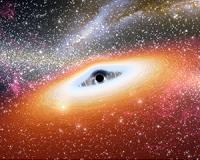 |
Leicester, England (UPI) Sep 8, 2010 Astronomers in Britain say confirmation of an extreme X-ray source in a distant galaxy bolsters the theory of a new class of black hole. A group of international astronomers in the United Kingdom, France and the United States, led by the University of Leicester, have found proof to confirm the distance and brightness of the most extreme ultra-luminous X-ray source discovered, a university release said Wednesday. Named HLX-1, the X-ray source is in a galaxy about 300 million light years from the Earth, and its extreme brightness suggests it may contain what astrophysicists term an intermediate class black hole. While the existence of this class of black hole, with masses between a hundred and several hundred thousand times that of the Sun, has been theorized, such black holes had not previously been reliably detected and their existence has been fiercely debated among the astronomical community. Ultra-luminous X-ray sources have been considered promising candidates for intermediate mass black holes, with masses between stellar mass black holes (around 3 to 20 times the mass of the Sun) and the super-massive black holes found in the centers of most galaxies with around 1 million to 1 billion times the mass of the Sun. Whether all ultra-luminous X-ray sources contain intermediate mass black holes is still uncertain, researchers say.
Share This Article With Planet Earth
Related Links Understanding Time and Space
 First mega black holes were born soon after 'Big Bang'
First mega black holes were born soon after 'Big Bang'Paris (AFP) Aug 25, 2010 The first "supermassive" black holes were created relatively soon after the Big Bang that created the Universe, a finding which could rewrite theories about the formation of galaxies, scientists said on Wednesday. Ordinary black holes are entities of mass whose gravitational pull is so huge that not even light can escape them. But they are dwarfs compared to so-called supermassive black ... read more |
|
| The content herein, unless otherwise known to be public domain, are Copyright 1995-2010 - SpaceDaily. AFP and UPI Wire Stories are copyright Agence France-Presse and United Press International. ESA Portal Reports are copyright European Space Agency. All NASA sourced material is public domain. Additional copyrights may apply in whole or part to other bona fide parties. Advertising does not imply endorsement,agreement or approval of any opinions, statements or information provided by SpaceDaily on any Web page published or hosted by SpaceDaily. Privacy Statement |